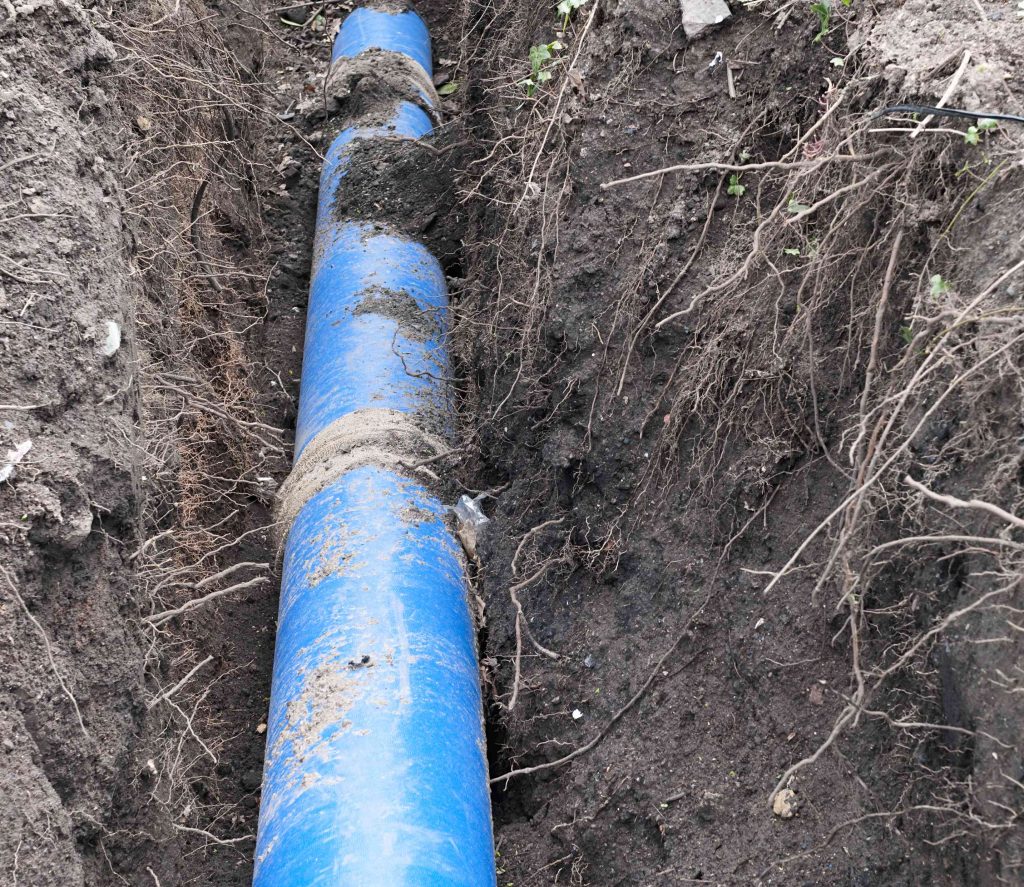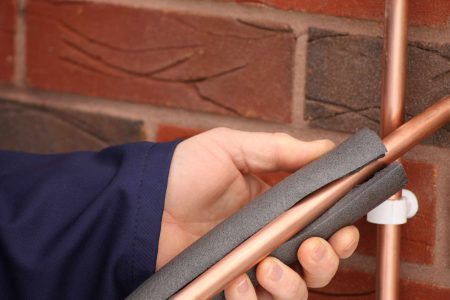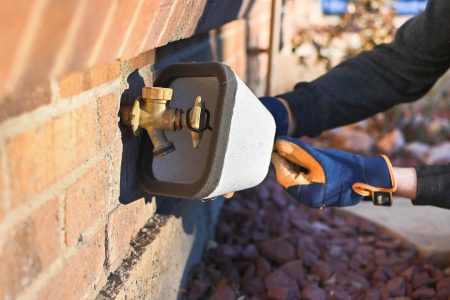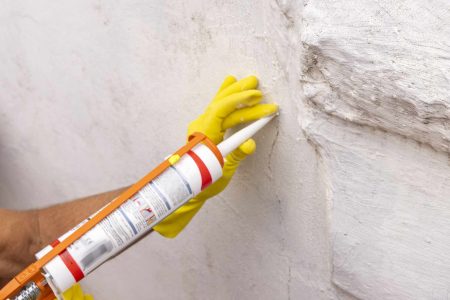A failed sewer line understandably strikes fear in the hearts of homeowners. For one, the high cost of sewer line replacement can make a major dent in most homeowners’ bank accounts. For another, a completely failed sewer line means that all wastewater operations in the house must cease: toilets, sinks, showers, and bathtubs.
When a contractor produces an estimate on costs to fix your sewer line, the estimate includes both the cost of digging the trench with earth-moving equipment and the cost of the actual pipe replacement.
If you are up to the task of hand-digging the trench required to access the old sewer line, you can cut costs dramatically. If you go the next step and replace the line by yourself, the cost of replacing the sewer line comes to cents on the dollar as compared to full-service replacement by a contractor.
How Deep Is the Sewer Line in Your Yard?
The depth of the sewer line in your yard depends on local building codes, which are often based on local geology and climate.
Sewer lines on private property can be as shallow as 18 to 30 inches deep or as deep as 5 to 8 feet deep. In cold climates, the pipe will be buried deeper to prevent freezing in the winter.
If the pipe cannot be buried to code-required depth, the code may provide some concessions for burying the line higher. For example, Anchorage, Alaska, with average lows that reach below 0°F from November through the beginning of March, requires that sewer lines be buried to 8 feet. But if that depth cannot be achieved, code allows for the line to be “fully encapsulated with a minimum of three inches of rigid foam. “
Pipe depth is not always a matter of climate. Even in warm climates, the pipe can sometimes be buried very deep—it may depend on where your community’s sewer mains are located.
Skill Considerations
Digging a trench down to your sewer line is mostly just a matter of hard work. It is not technically difficult, but it can be extremely demanding physically. No materials are required, and the tools are simple ones that many homeowners already have on hand or can rent.
One adult in reasonably good shape may expect to dig a sewer trench 4 feet deep by 8 feet long by 3 feet wide in one weekend of long workdays. This estimate is based on the assumption that you have loose soil with a moderate number of roots to cut through. Clay or densely packed soil, as well as the presence of many large roots, can increase digging time significantly.
Temperature and Climate
Cold climates can present additional complications. In these areas, the sewer pipe can be quite deep because the frost line (the depth to which the ground freezes in winter) may be 4 feet or more below the surface.
Also, if your sewer line fails in winter, you are faced with the difficult task of breaking through the frozen ground in freezing temperatures. This may be impossible to do by hand, and you may need to call in earth-moving equipment.
Safety Considerations
Warning
Digging and then working in a deep trench can be dangerous. According to the CDC, an average of about 20 workers die annually when the earthen walls of trenches collapse on them while they are working within the trenches. An open trench also poses a distinct hazard to children and pets. Make sure to take all necessary precautions to prevent an accident.
Trench shields prevent the walls of the trench from collapsing, and OSHA (Occupational Safety and Health Administration) regulations require the use of trench shields for trenches 5 feet deep or deeper. As a homeowner, you are not bound by OSHA regulations, but it is wise to follow OSHA guidelines for your own safety.
Be sure to create an angled slope inclined away from the trench or create bench steps. Soil and other materials from the trench should be removed at least 2 horizontal feet from the edges of the trench.
What You’ll Need
Equipment / Tools
- Marking paint
- Sledgehammer (as needed)
- Shovel
- Pickax
- Pruning shears or handsaw
- Chain saw (as needed)
- Trench shields (as needed)
- Gravel and soil (as needed)
Materials
- Yard waste bags (as needed)
- Soluble marking paint
- Twine and stakes
Instructions
-
Locate the Sewer Line
One of the most critical steps in digging a trench for sewer line replacement is making sure you are digging in the right location. If you have no idea where your sewer line runs, a video camera inspection can tell you. The technician will run the camera from the sewer clean-out and down the sewer line from your house and can stop at various points. The camera has a radio transmitter that signals its location. At any point, the technician can sweep a locator over the ground so that it reads the signal, allowing you to mark the ground directly above the sewer pipe.
Be as accurate as possible because you will pay a high price in useless labor for hand-digging at the wrong spot. Work with the technician until you are certain that you have found the accurate location, and then paint a line along the entire length of the pipe with marking paint.
-
Locate Other Utility Lines
Call your local utility locator number. This is usually a free service to residents that is funded and managed by utility companies. Technicians will mark your yard for electrical, water, gas, and other vital services. Do not forget that there may be other homeowner-installed services such as sprinkler lines and landscape lights in your yard; these will not be marked by utility companies.
-
Mark the Dig Location
Use the twine and string and the soluble marking paint to mark the dig location. Mark the actual sewer line with paint (a line which will eventually get obliterated) and a line on each side that will not be moved during the dig.
-
Apply for a Permit
It is highly likely that your community requires a permit as a safety measure to ensure that the work is done correctly. An inspector will visit the worksite to make sure the work has been done in compliance with the code. In the case of a sewer line replacement, this is normally done after the new sewer line has been installed but before the trench has been filled.
-
Break or Remove Obstructions
Before you can get to the soil, you may have to remove obstructions such as concrete or brick sidewalks, driveways, or slabs. Use an 8-pound sledgehammer to break up concrete, starting on the edge. For large concrete structures, it’s worth renting an electric jackhammer or chipping gun at a tool rental center.
-
Dig the Sewer Trench
Dig straight down, minimizing side digging as much as possible for the time being. Later, you will need to extend the trench sideways so that you can stand in the pit and create access to the sewer line. But do as little side digging as possible until you have located the sewer line.
-
Cut Tree Roots
As you dig, you may need to clip or saw off tree and shrub roots as you encounter them. Some small roots can be severed with your shovel blade. Other roots should be clipped with pruning shears or a hand saw. Heavier roots will require a chainsaw. Place roots in yard clean-up bags for later removal.
-
Assess the Sewer Line Problem
If your sewer problem is an emergency, you may smell the pipe before you see it. You might find that the soil is saturated with waste water. If the sewer line has been well laid, the appearance of a gravel layer will alert you that you are close to the sewer line.
At this point, dig rather carefully as you excavate space around the sewer line, which may be a plastic pipe, clay pipe, or cast-iron pipe. You might even find several types of pipe spliced together. Clear away a good amount of soil all around the pipe by widening the trench, which will allow the contractor easy access to replace it.
Warning
Until the sewer replacement is complete, it is very important to guard the trench against pets or children who might fall in. This can be done by covering the trench or by erecting sturdy temporary fencing to guard against intrusion.
-
Complete the Project
After the sewer pipe replacement is complete, make sure to have the work inspected before filling in the trench with gravel and soil. Surround the pipe with a layer of gravel before filling in soil to help protect the pipe from soil movement. As you fill in the trench, periodically compress the soil to prevent future settling of the earth.
Read the full article here









